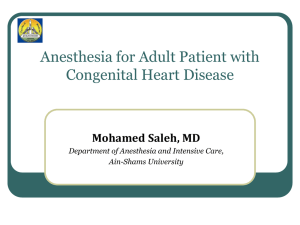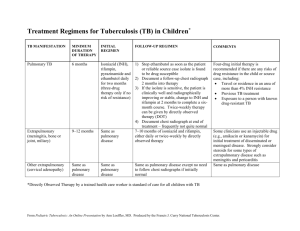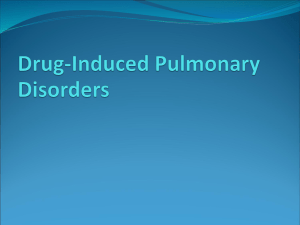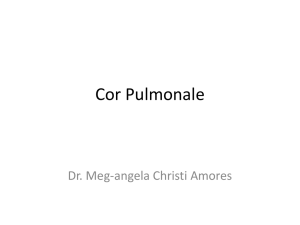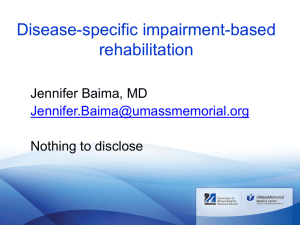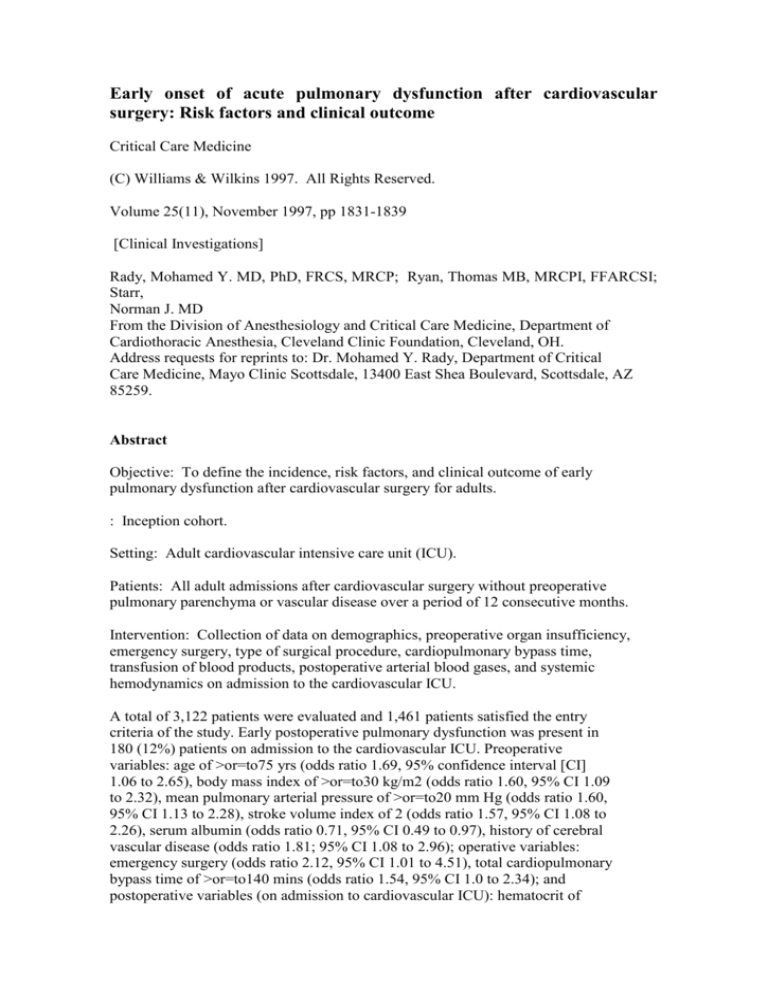
Early onset of acute pulmonary dysfunction after cardiovascular
surgery: Risk factors and clinical outcome
Critical Care Medicine
(C) Williams & Wilkins 1997. All Rights Reserved.
Volume 25(11), November 1997, pp 1831-1839
[Clinical Investigations]
Rady, Mohamed Y. MD, PhD, FRCS, MRCP; Ryan, Thomas MB, MRCPI, FFARCSI;
Starr,
Norman J. MD
From the Division of Anesthesiology and Critical Care Medicine, Department of
Cardiothoracic Anesthesia, Cleveland Clinic Foundation, Cleveland, OH.
Address requests for reprints to: Dr. Mohamed Y. Rady, Department of Critical
Care Medicine, Mayo Clinic Scottsdale, 13400 East Shea Boulevard, Scottsdale, AZ
85259.
Abstract
Objective: To define the incidence, risk factors, and clinical outcome of early
pulmonary dysfunction after cardiovascular surgery for adults.
: Inception cohort.
Setting: Adult cardiovascular intensive care unit (ICU).
Patients: All adult admissions after cardiovascular surgery without preoperative
pulmonary parenchyma or vascular disease over a period of 12 consecutive months.
Intervention: Collection of data on demographics, preoperative organ insufficiency,
emergency surgery, type of surgical procedure, cardiopulmonary bypass time,
transfusion of blood products, postoperative arterial blood gases, and systemic
hemodynamics on admission to the cardiovascular ICU.
A total of 3,122 patients were evaluated and 1,461 patients satisfied the entry
criteria of the study. Early postoperative pulmonary dysfunction was present in
180 (12%) patients on admission to the cardiovascular ICU. Preoperative
variables: age of >or=to75 yrs (odds ratio 1.69, 95% confidence interval [CI]
1.06 to 2.65), body mass index of >or=to30 kg/m2 (odds ratio 1.60, 95% CI 1.09
to 2.32), mean pulmonary arterial pressure of >or=to20 mm Hg (odds ratio 1.60,
95% CI 1.13 to 2.28), stroke volume index of 2 (odds ratio 1.57, 95% CI 1.08 to
2.26), serum albumin (odds ratio 0.71, 95% CI 0.49 to 0.97), history of cerebral
vascular disease (odds ratio 1.81; 95% CI 1.08 to 2.96); operative variables:
emergency surgery (odds ratio 2.12, 95% CI 1.01 to 4.51), total cardiopulmonary
bypass time of >or=to140 mins (odds ratio 1.54, 95% CI 1.0 to 2.34); and
postoperative variables (on admission to cardiovascular ICU): hematocrit of
>or=to30% (odds ratio 2.46, 95% CI 1.71 to 3.56), systemic mean arterial
pressure of >or=to90 mm Hg (odds ratio 1.67, 95% CI 1.13 to 2.42), and cardiac
index of >or=to3.0 L/min/m2 (odds ratio 2.09, 95% CI 1.44 to 3.01) were
predictors of early postoperative pulmonary dysfunction. Pulmonary dysfunction
was associated with a postoperative increase of serum creatinine (1.36 +/- 0.4
vs. 1.24 +/- 0.4 mg/dL, p
Conclusions: The incidence of early postoperative pulmonary dysfunction is
uncommon; however, once developed, it is associated with increased morbidity and
mortality after cardiovascular surgery. Advanced age, large body mass index,
preoperative increased pulmonary arterial pressure, low stroke volume index,
hypoalbuminemia, history of cerebral vascular disease, emergency surgery, and
prolonged cardiopulmonary bypass time are risk factors for early onset of severe
pulmonary dysfunction after surgery. Postoperative hematocrit and systemic
hemodynamics suggest that early postoperative pulmonary dysfunction can be a
component of a generalized inflammatory reaction to cardiovascular surgery.
(Crit Care Med 1997; 25:1831-1839)
---------------------------------------------Key Words: cardiovascular surgery; cardiopulmonary bypass; pulmonary dysfunction;
predictors; visceral ischemia; hypoalbumlnemia; cerebral vascular disease;
hemodynamics; hematocrit; outcome
Acute pulmonary dysfunction is a common etiologic factor for early postoperative
respiratory failure. The assessment of pulmonary function in postoperative
patients who are mechanically ventilated is based on the evaluation of arterial
blood gases, respiratory system compliance, and chest radiography [1]. A
Consensus Statement by North American and European investigators agreed on a
precise definition of acute pulmonary injury: a PaO2/FIO2 ratio of 2/FIO sub 2
ratio of
Cardiopulmonary bypass, which is essential to most cardiovascular operations,
has been implicated in early onset of pulmonary dysfunction after cardiovascular
surgery [3]. Massive blood transfusion, low cardiac output syndrome, gastric
aspiration, surgical tissue trauma, and sepsis syndrome have been recognized as
additional risk factors to precipitate postoperative pulmonary dysfunction
[4,5]. Early onset of postoperative pulmonary dysfunction has been associated
with an injury of the pulmonary microvascular and alveolar-capillary membrane
secondary to systemic inflammation [6]. Systemic inflammatory response has been
attributed to prolonged exposure of blood to nonphysiologic surfaces, perioperative
ischemia of the splanchnic viscera (especially the gastrointestinal tract and
liver), and endotoxin release into the bloodstream after cardiopulmonary bypass
[7-9]. Both ischemia of the splanchnic viscera and endotoxemia are potent
stimuli for the synthesis of cytokines and contribute to systemic inflammatory
response and the development of multiple organ dysfunction after cardiovascular
surgery [10,11].
Previous work [12] performed in patients undergoing cardiac surgery has focused
on the risk factors that determined prolonged mechanical ventilation and delayed
onset of pulmonary dysfunction days after surgery. The few studies [6,13] that
examined the onset of acute pulmonary dysfunction within a few hours after
surgery were primarily concerned with the pathophysiologic characteristics of
pulmonary dysfunction examined in small cohorts. From previous work, neither the
incidence of nor the potential risk factors for early pulmonary dysfunction
after cardiovascular surgery could be answered [14]. The description of
predisposing factors for early postoperative pulmonary dysfunction can help
future identification of high-risk patients before surgery. Manipulation of
potential factors or implementation of novel therapy to attenuate or prevent
pulmonary injury can be applied in a selected group of high risk patients.
Therefore, a cohort study was designed: a) to examine the incidence of early
pulmonary dysfunction after cardiovascular surgery; b) to identify the
perioperative risk factors for early onset of pulmonary dysfunction; and c) to
examine the implications of pulmonary dysfunction on clinical outcome:
postoperative organ dysfunction, length of stay in the cardiovascular intensive
care unit (ICU) and hospital, and death.
MATERIALS AND METHODS
Study Population.
The study was approved by the Institutional Review Committee for Human Research.
All adult admissions from the cardiothoracic operating room to the cardiovascular
ICU (a total of 54 beds) over a period of 12 consecutive months were evaluated
for entry into the study. Patients with history of preoperative obstructive or
restrictive pulmonary disease, pulmonary arterial hypertension (mean pulmonary
arterial pressure of >or=to25 mm Hg), or abnormal arterial blood gases before
surgery were excluded from entry to the study. Surgical procedures such as the
placement of ventricular assist device, extracorporeal membrane oxygenation, and
heart transplantation were also exclusion criteria.
Outcome Measures.
The primary outcome measure was the development of "early" acute pulmonary
dysfunction after cardiovascular surgery. A modified lung injury definition was
used to define oxygenation and radiologic criteria for acute pulmonary
dysfunction. The criteria were: mechanical ventilation with a PaO2/FIO2 ratio of
Other measures of clinical outcome after cardiovascular surgery were also
evaluated. These measures included: a) postoperative myocardial infarction: the
diagnosis of myocardial infarction required new Q waves that were >or=to40 msecs
long and >or=to25% of R wave plus a creatine phosphokinase myocardial band of
>or=to50 IU or an aspartate aminotransferase concentration of >or=to80 units/L;
b) low cardiac output syndrome: postoperative cardiac index of 2 on pharmacologic
and/or intra-aortic balloon pump support; c) initial and total duration of
mechanical ventilation; d) neurologic complications (focal brain lesion
confirmed by clinical findings and/or computed tomographic scan, diffuse
encephalopathy with >24 hrs of severely altered mental status, and/or failure to
awaken postoperative); e) nosocomial infections: a documented source of
infection (lungs, vascular catheters, wound, mediastinum, urinary tract, blood)
by a positive microbiological culture, temperature of >38.5[degree sign]C or 12
x 109 or 9/L; f) total length of stay in the cardiovascular ICU and hospital; g)
death during hospital stay.
Measurements.
Previous literature [1,3,12,14] demonstrated several variables which could be
associated with early pulmonary dysfunction after cardiovascular surgery. These
variables included demographic characteristics: age, gender, weight, body
surface area, body mass index {weight/(height)2}, history of smoking, systemic
hypertension, previous myocardial infarction, congestive heart failure,
peripheral vascular surgery or dilation, diabetes mellitus (insulin- and
noninsulin-dependent), and cerebral vascular disease (previous stroke or carotid
surgery). Preoperative laboratory data pertaining to chronic organ system
insufficiency (e.g., serum albumin, total bilirubin, creatinine) were used to
determine chronic organ system insufficiency defined in a previous study [14].
Severe left ventricular dysfunction was diagnosed by ventriculogram by
angiography which generally corresponded to an ejection fraction of or=to1.9
mg/dL or preoperative dialysis; hepatic dysfunction was defined as a total serum
bilirubin of >or=to1.9 mg/dL or albumin of
Operative risk factors included emergency surgery for one of the following
conditions: unstable angina, cardiogenic shock, ischemic valvular dysfunction
that could not be controlled medically, leaking or dissection of thoracic aortic
aneurysms, complications of routine cardiac catheterization or percutaneous
transluminal coronary angioplasty. Redo operation implied a prior operation on
the heart or thoracic aorta. Data pertaining to the type of operative procedures
performed (isolated or combined), total cardiopulmonary bypass time, aortic
cross-clamp time, circulatory arrest time (if applicable), total operating time,
and the number of units of transfused red cells, platelets, and clotting factors
during the operation were obtained from operation, anesthesia, and perfusion
records. Placement of intra-aortic balloon pump on completion of surgery and
transfer to the cardiovascular ICU was also noted.
On admission to the cardiovascular ICU, hemodynamic variables, ventilatory
settings, arterial blood gases, hematocrit, and core body temperature were
recorded. The requirements of vasopressors, inotropes and nitrodilators after
separation from cardiopulmonary bypass and other laboratory data obtained on the
first postoperative day in the cardiovascular ICU were also recorded. Additional
biochemical, hematologic, and microbiological laboratory data were obtained
during the cardiovascular ICU.
Data Collection.
Data were collected during the hospital admission on all patients who had
undergone cardiovascular surgery before admission to the cardiovascular ICU. All
data were collected daily, concurrent with care on preprinted forms, by
experienced and trained database personnel using the medical record, anesthesia
and perfusion records, and postoperative flow sheets as sources. To confirm the
reliability of the data, 10% of the patient charts were randomly selected and
reabstracted by physicians blinded to the initial data collection. Analysis
using the kappa statistics demonstrated a good agreement (kappa range 0.66 to
0.987) between the reference group and the audited sample.
Statistical Analysis.
All continuous variables were presented as mean +/- SD and interquartile range
when appropriate. Analysis was performed with Student's t-test or Wilcoxon
rank-sum test when appropriate. Repeated-measure analysis of variance examined
the effect of surgery on hemodynamic variables and its interaction with early
pulmonary dysfunction. Categorical variables were expressed as actual numbers
and percentages and analyzed with chi-square or Fisher's exact test. The
variables that had significant association with early postoperative pulmonary
dysfunction as well as other variables judged as clinically relevant variables
were entered into a stepwise multiple logistic-regression model. Different
cutoff values for continuous variables were examined to determine the improvement
of the logistic model prediction. All statistical tests were two tailed and
statistical significance was accepted at p
RESULTS
There were 3,122 patients admitted to the cardiovascular ICU and evaluated for
entry into the study. Of these patients, 1,564 patients were found to have
preoperative obstructive or restrictive pulmonary disease, abnormal arterial
blood gases, or significant pulmonary arterial hypertension. An additional 97
patients were excluded because of the type of surgical operations performed such
as heart transplant or placement of ventricular assist device and extracorporeal
membrane oxygenation. A total of 1,461 patients were eligible for the study, of
which 180 patients (12%) satisfied the criteria of early postoperative pulmonary
dysfunction.
The demographics, preoperative historical characteristics, and chronic organ
insufficiency are listed in Table 1. Patients with early postoperative pulmonary
dysfunction had higher mean age, body weight, body mass index and body surface
area, and incidence of cerebral vascular disease than other patients. Gender and
other preoperative historical characteristics: smoking, congestive heart
failure, hypertension, previous myocardial infarction, diabetes mellitus,
peripheral vascular disease, cardiogenic shock, and infective endocarditis were
similar in both groups of patients, although preoperative placement of
intra-aortic balloon pump was more frequent in those patients with postoperative
pulmonary dysfunction. Both groups of patients had similar preoperative chronic
organ insufficiency: low left ventricular ejection fraction, serum creatinine,
creatinine of >or=to1.9 mg/dL or chronic dialysis, serum bilirubin, and
bilirubin of >or=to1.9 mg/dL. The mean preoperative serum albumin concentration
was lower in patients with early onset of pulmonary dysfunction; in this same
group of patients, there were more patients with preoperative serum albumin of
Patients with early postoperative pulmonary dysfunction had similar numbers of
redo operations, operative procedures (isolated or combined) such as coronary
artery bypass grafting, aortic, mitral, and tricuspid valves surgery, aortic
cross-clamp, and operating times compared with other patients in the study
(Table 2). The distribution of median sternotomy and thoractomy incisions were
similar among the two groups of patients. Patients with early postoperative
pulmonary dysfunction had more emergency surgery, especially on the thoracic
aorta, longer total cardiopulmonary bypass time, circulatory arrest time, number
of cases on circulatory arrest, and placement of intraaortic balloon pump after
separation from cardiopulmonary bypass than other patients. They were also
transfused with more blood products including units of red cells, red cells
>or=to10 units, units of platelets, platelets >or=to12 units, and units of fresh
frozen plasma during surgery. Reoperation for postoperative bleeding was similar
in both groups of patients. Although the frequency of administration of
dobutamine, norepinephrine, phenylephrine, and nitrodilators were similar in
both groups of patients, amrinone and epinephrine were more frequently infused
in patients with early postoperative pulmonary dysfunction after separation from
cardiopulmonary bypass (Table 2).
The characteristic hemodynamic responses associated with early pulmonary
dysfunction after cardiovascular surgery are shown in Table 3. Preoperative
heart rate, mean arterial pressure, central venous pressure, and hematocrit were
similar in all patients. Patients with early postoperative pulmonary dysfunction
had higher preoperative pulmonary systolic pressure and slightly increased
pulmonary diastolic and mean pulmonary pressure at a lower preoperative cardiac
index, stroke volume index, and systemic oxygen delivery than other patients.
All patients had significant increases in heart rate, central venous pressure,
and simultaneous decreases in mean systemic arterial pressure, stroke volume
index, hematocrit, and systemic oxygen delivery after surgery. In contrast,
patients with early postoperative pulmonary dysfunction demonstrated higher
postoperative mean systemic arterial pressure, cardiac index, stroke volume
index, hematocrit, and systemic oxygen delivery than other postoperative
patients (Table 3). Postoperative heart rate, central venous pressure, pulmonary
systolic, diastolic, and mean pressures were similar in both groups of patients.
Predictors of early postoperative pulmonary dysfunction included: preoperative
variables-age of >or=to75 yrs, body mass index of >or=to30 kg/m2, mean pulmonary
arterial pressure of >or=to20 mm Hg, stroke volume index of 2, serum albumin,
and history of cerebral vascular disease; operative variables-emergency surgery
and total cardiopulmonary bypass time of >or=to140 mins; postoperative variables
on admission to the cardiovascular ICU-hematocrit of >or=to30%, mean arterial
pressure of >or=to90 mm Hg, and cardiac index of >or=to3.0 L/min/m2 (Table 4).
The logistic regression model had a goodness-of-fit p =.98 (i.e., the model had
a good fit for the observed events to predict early postoperative pulmonary
dysfunction).
Table 4. Multiple logistic regression analysis of predictors of early pulmonary
dysfunction after cardiovascular surgery
---------------------------------------------Patients with early postoperative pulmonary dysfunction had lower PaO sub 2 and
pH and higher PaCO2, positive endexpiratory pressure, and minute volume
requirements compared with other postoperative patients (Table 5). Arterial
bicarbonate concentration and core body temperature were similar in both groups
of patients. Serum creatinine was higher in patients who developed early
pulmonary dysfunction than other postoperative patients on the first postoperative
day. The incidence of subsequent low cardiac output syndrome in the cardiovascular
ICU was higher in patients with early postoperative pulmonary dysfunction,
although postoperative myocardial infarction was similar in both groups. Of
patients who had serial blood lactate concentrations measured after surgery, the
peak blood concentration was higher in patients with postoperative pulmonary
dysfunction (n = 24) than other postoperative patients (n = 89) (median
[interquartile range]: 6.9 [3.4 to 10.8] vs. 4.2 [2.4 to 8.1] mmol/L, respectively,
p
There were significant associations between early pulmonary dysfunction and the
duration of mechanical ventilation (odds ratio 1.15, 95% confidence interval
[CI] 1.06 to 1.24, p
DISCUSSION
The incidence of early pulmonary dysfunction in this study was surprisingly low
at 12% after cardiovascular surgery and in agreement with previous studies
[3,12,13]. A characteristic hemodynamic response to cardiovascular surgery
included tachycardia, depressed stroke volume, increased central venous,
pressure and lowered systemic mean arterial pressure. These hemodynamic changes
could be attributed to postoperative reduction of ventricular and venous
compliance, impaired regulation of arterial vasomotor tone, and intraoperative
hemodilution. Intraoperative hemodilution, in addition to blood loss, was
responsible for lowering hematocrit and systemic oxygen delivery in all patients
after surgery.
The definition criteria for early pulmonary dysfunction did not include
pulmonary artery balloon occlusion pressure or pulmonary artery occlusion
pressure, which is frequently used to differentiate between pulmonary edema
secondary to an increase in alveolar-capillary permeability from excessive
pulmonary capillary hydrostatic pressure. However, pulmonary artery occlusion
pressure becomes an unreliable guide of left ventricular diastolic filling or
pulmonary capillary hydrostatic pressure especially when left ventricular
dynamic compliance changes over time [16]. The hemodynamic response noted in the
study suggested dramatic alteration in ventricular compliance in both patients
with and without pulmonary dysfunction after cardiovascular surgery. Core body
rewarming, high concentrations of circulating catecholamines (endogenous or
administered exogenous) and nitrodilators could explain the dynamic alteration
of left and right ventricular diastolic properties and compliance immediately
after separation from cardiopulmonary bypass.
Early postoperative pulmonary dysfunction was characterized by poor alveolar gas
exchange. The early pulmonary dysfunction apparent on arrival to the cardiovascular
ICU was not salutatory and prolonged the time required for mechanical ventilation
after surgery. Severe pulmonary dysfunction associated with a decrease of
PaO2/FIO2 ratio to
Hemodynamic Correlates of Early Postoperative Pulmonary Dysfunction.
Patients with early onset of pulmonary dysfunction had higher cardiac index
(i.e., hyperdynamic circulation) which attenuated the decrease in systemic
oxygen delivery immediately after surgery and on admission to the cardiovascular
ICU. Despite the higher requirements for inotropic medications, the increase in
cardiac index was insufficient to restore systemic oxygen delivery to preoperative
values. Myocardial depression may have been more pronounced with early onset of
pulmonary dysfunction after surgery. Both hyperdynamic circulation and
myocardial depression have been described as components of generalized
inflammatory reaction secondary to intraoperative visceral ischemia [18,19].
Periods of intraoperative regional hypoperfusion and ischemia precipitated
tissue hypoxia which could be quantified as an oxygen debt [20,21]. Inadequate
augmentation of cardiac index and systemic oxygen delivery delayed the
replenishment of regional perfusion and reversal of tissue hypoxia or oxygen
debt and translated into a higher incidence of postoperative pulmonary and other
organ dysfunction and mortality in high risk surgical patients [18,22]. Of
significant interest, early acute pulmonary dysfunction was also associated with
higher incidence of acute renal and neurologic dysfunction and mortality after
cardiovascular surgery. It is plausible that patients who developed early
postoperative pulmonary dysfunction had longer periods of intraoperative
regional hypoperfusion and ischemia than other patients. A prolonged cardiopulmonary
bypass time was a predictor of early pulmonary dysfunction and strengthened the
association with profound intraoperative regional ischemia and hypoxia. The
higher peak concentration of blood lactate, in patients who had serial
measurements after surgery, indicated a more profound ischemic insult associated
with the development of early pulmonary dysfunction.
Intraoperative hemodilution decreased postoperative hematocrit in all of the
study patients. Postoperative hematocrit was decreased to a lesser degree in
patients with early pulmonary dysfunction which could be explained by transfusion
of more units of red cells during surgery than in other patients. However, an
increased postoperative hematocrit predicted early pulmonary dysfunction
independent of the number of red cells units transfused during surgery. An
alternative explanation would be that an increased hematocrit on admission to
the cardiovascular ICU reflected intravascular hemoconcentration and relative
depletion of plasma volume from increased systemic vascular permeability which
was a surrogate marker of generalized inflammatory reaction to surgery [13,17].
The relationship of high hematocrit and increased systemic vascular permeability
could account for the prediction of early postoperative pulmonary dysfunction.
Risk Factors for Early Postoperative Pulmonary Dysfunction.
Cerebral vascular disease and large body mass index were predictors of early
pulmonary dysfunction after cardiovascular surgery. Cerebral vascular disease is
a common correlate of diffuse arterial disease of other internal viscera
(including brain) which can aggravate intraoperative regional ischemia during
cardiopulmonary bypass and/or circulatory arrest. The disproportionate increase
of body mass index to cardiopulmonary bypass pump flow rates indexed to body
surface area can also exacerbate intraoperative hypoperfusion and ischemia of
splanchnic viscera. The cumulative effect of diffuse arterial disease, large
body mass index and prolonged cardiopulmonary bypass time on splanchnic ischemia
can result in profound perioperative tissue hypoxia and precipitate early
postoperative pulmonary dysfunction [23].
Advanced age and decreased stroke volume index were preoperative predictors of
early postoperative pulmonary dysfunction. Advanced age has been associated with
diminished tolerance to regional and global hypoperfusion and poor physiologic
reserve for postoperative augmentation of cardiac index and systemic oxygen
delivery for rapid amelioration of ischemia of splanchnic viscera [18]. Those
patients with early postoperative pulmonary dysfunction had lower preoperative
cardiac index and systemic oxygen delivery consistent with limited physiologic
reserve compared with other patients. A lowered preoperative stroke volume index
portrayed a preexisting deficiency of global perfusion and oxygen delivery and
confirmed poor physiologic reserve in patients prone to acute postoperative
pulmonary dysfunction. Advanced age and large body mass index are also
associated with postoperative increase of pulmonary interstitial fluid which can
decrease functional residual capacity and alveolar recruitment for gas exchange
[24].
Preoperative serum albumin concentration was a predictor of early pulmonary
dysfunction after cardiovascular surgery. Low serum albumin has been used as a
marker of malnutrition, chronic liver insufficiency, and/or increased vascular
permeability in critical illness [25,26]. Nutritional depletion of albumin has
been associated with immunologic dysfunction and pronounced systemic inflammatory
response to ischemic insult which can potentially exacerbate pulmonary
dysfunction [25]. In this study, low serum albumin may have also been a sequel
of chronic liver insufficiency even though serum bilirubin was not a preoperative
predictor of pulmonary dysfunction. Chronic liver insufficiency has been found
to be a predisposing factor for acute pulmonary injury and dysfunction [1]. Low
serum albumin may also have been a marker of increased vascular permeability to
albumin which is often associated with a generalized increase of vascular
capillary permeability [27]. Low serum albumin decreases plasma oncotic pressure
and modifies the balance of Starling forces after an acute increase in
alveolar-capillary permeability. Hypoalbuminemia can exacerbate the accumulation
of pulmonary interstitial water and contribute to postoperative pulmonary
dysfunction.
A preoperative increase of mean pulmonary arterial pressure was a predictor of
early postoperative pulmonary dysfunction. Preoperative mean pulmonary arterial
pressure remained a significant predictor of postoperative pulmonary dysfunction
even after exclusion of patients who had moderate to severe pulmonary hypertension
from the study. Pulmonary vascular endothelial dysfunction is commonly
associated with increased pulmonary arterial pressure and reduced pulmonary
blood flow [28]. Pulmonary vascular endothelial dysfunction may increase the
susceptibility for postoperative pulmonary dysfunction after insults that
initiate acute alveolar-capillary injury and systemic inflammatory response.
Emergency surgery on the heart and thoracic aorta was a predictor of early
postoperative pulmonary dysfunction. Emergency cardiovascular surgery is
commonly performed for life-threatening preoperative hemodynamic events that
inherently increase postoperative morbidity and mortality [14]. Low cardiac
index, preoperative placement of intra-aortic balloon pump, thromboembolism from
atheromatous plaques in the thoracic aorta, or the involvement of visceral
arteries in dissecting or leaking aneurysms can induce regional hypoperfusion
and precipitate ischemia of splanchnic organs. Progressive regional and global
ischemia can develop with additional insults of prolonged cardiopulmonary bypass
and/or circulatory arrest, resulting in early postoperative organ (including
pulmonary) dysfunction [29,30].
Massive transfusion of blood products and total cardiopulmonary bypass, aortic
cross-clamp, and circulatory arrest times have been reported as risk factors for
early postoperative pulmonary dysfunction [3,4,12]. Our observations concurred
with previous studies: greater intraoperative transfusion requirements of blood
products (red cells, platelets, and fresh frozen plasma), longer total
cardiopulmonary bypass, aortic cross-clamp, and circulatory arrest times in
patients who developed early pulmonary dysfunction. However, the cardiopulmonary
bypass time was the only significant intraoperative factor from these selected
variables to predict early postoperative pulmonary dysfunction. A recent report
[31] has raised doubts on the clinical importance of transfusion of blood
products as a factor to precipitate acute pulmonary dysfunction. Transfusion of
blood products is frequently associated with other important variables such as
prolonged cardiopulmonary bypass time, shock, underlying emergency condition, or
extensive surgical tissue trauma which have not been accounted for in previous
studies. This study used multivariate analysis to examine the confounding
effects of other measured variables associated with intraoperative transfusion
of blood products. The predictors of the surrogate intraoperative regional and
global ischemia rather than the transfusion of blood products determined early
pulmonary dysfunction after cardiovascular surgery.
Clinical Outcome of Early Postoperative Pulmonary Dysfunction.
The incidence of early postoperative pulmonary dysfunction was associated with
renal dysfunction, neurologic complications, nosocomial infections, prolonged
stay in the cardiovascular ICU, and hospital death. The incidence of extrapulmonary
organ dysfunction such as cardiac, renal, neurologic, as well as nosocomial
infections accounted for the high mortality rate associated with early onset of
pulmonary dysfunction in the current study. Other investigators [1] reported
similar findings of higher incidence of nonpulmonary organ dysfunction and
nosocomial infections following acute pulmonary dysfunction which contributed to
an increased hospital mortality. Postoperative neurologic and renal complications
share predisposing factors similar to postoperative pulmonary dysfunction such
as widespread arterial diseases, thromboembolism from thoracic aorta, shock, and
emergency cardiovascular surgery [12]. Preoperative cerebral vascular disease
was a predictor for early pulmonary dysfunction and explained the strong
association with postoperative neurologic complications. The incidence of
nosocomial infections could be related to immune-suppression, invasive
instrumentation, and prolonged mechanical ventilation and stay in the ICU
[12,18,22].
Therapy to prevent or attenuate the incidence of early pulmonary dysfunction can
have a direct impact on the utilization of intensive care and hospital
resources, and indirectly, on the costs of health care. As the cost of care
becomes a major constraint on the delivery of cost-effective health care,
patients at risk for early pulmonary dysfunction should be identified before
cardiovascular surgery. Preoperative weight reduction to ideal body mass index
and nutritional supplementation to correct low serum albumin may attenuate the
severity of early pulmonary dysfunction. Perioperative transesophageal
echocardiography and transcranial doppler can be useful to monitor and minimize
the risk of thromboembolism from thoracic aorta into the cerebral and other
visceral circulation. Perioperative assessment and optimization of splanchnic
organs oxygenation (e.g., using gastrointestinal tonometry) can attenuate
perioperative regional ischemia and generalized inflammatory reaction after
cardiovascular surgery [32,33]. A recent study [34] indicated that intraoperative
hemofiltration can also be successful to reduce the delayed inflammatory
response to cardiopulmonary bypass and to attenuate acute pulmonary injury and
dysfunction in the immediate postoperative period.
Study Limitations.
The study used the modified lung injury definition to determine postoperative
pulmonary dysfunction which could have potentially misclassified patients and
underscored the risk of some of the measured variables. However, such a
misclassification was less likely since the concordance between the modified
lung injury definition and the Consensus American-European definition was >90%
when applied to high and low risk groups of patients for pulmonary dysfunction
[15]. Since the study set the PaO2/FIO2 ratio of 2/FIO2 ratio of
It is unclear if early severe pulmonary dysfunction after cardiovascular surgery
described in this patient population could be classified as traditional acute
respiratory distress syndrome (ARDS). The mortality from early postoperative
pulmonary dysfunction was 4%, which was far less than the mortality figure of
40% attributed to ARDS [1,5]. The study described certain predictors and
associated clinical outcome for early postoperative pulmonary dysfunction which
implied its distinctive characteristics from traditional ARDS. The study
presented indirect evidence that early severe pulmonary dysfunction was most
likely related to an acute alveolar-capillary injury and a component of a
generalized inflammatory reaction after cardiovascular surgery which were also
common features with ARDS. It is likely that both early postoperative pulmonary
dysfunction and ARDS share common underlying pathophysiologic events that
eventually lead to a similar pulmonary and systemic host response in the
postoperative patients.
Conclusion.
The incidence of early pulmonary dysfunction is uncommon after cardiovascular
surgery. Once pulmonary dysfunction has developed after surgery, there is an
increased likelihood of renal and neurologic complications, nosocomial
infections, prolonged mechanical ventilation, and death. Preoperative cerebral
vascular disease, large body mass index, advanced age, hypoalbuminemia,
increased mean pulmonary arterial pressures, emergency surgery, and prolonged
cardiopulmonary bypass time are risk factors for early pulmonary dysfunction
after cardiovascular surgery. Postoperative hematocrit and systemic hemodynamics
suggest that early postoperative pulmonary dysfunction could be a component of
generalized inflammatory reaction to cardiovascular surgery. Early pulmonary
dysfunction increases the utilization of intensive care and hospital resources
after cardiovascular surgery.
REFERENCES
1. Doyle RL, Szaflarki N, Modin GW, et al: Identification of patients with acute
lung injury. Predictors of mortality. Am J Respir Crit Care Med 1995; 152:
1818-1824 Bibliographic Links
2. Bernard GR, Artigas A, Brigham KL, et al: Report of the American-European
consensus conference on ARDS: Definitions, mechanisms, relevant outcomes and
clinical trail coordination. Intensive Care Med 1994; 20:225-232 Bibliographic
Links
3. Messent M, Sullivan K, Keogh BF, et al: Adult respiratory distress syndrome
following cardiopulmonary bypass: Incidence and prediction. Anesthesia 1992;
47:267-268 Bibliographic Links
4. Collins JA, James PM, Bredenberg CE, et al: The relationship between
transfusion and hypoxemia in combat casualties. Ann Surg 1978; 188:513-520
Bibliographic Links
5. Fowler AA, Hamman RF, Good JT, et al: Adult respiratory distress syndrome:
Risk with common predisposition. Ann Intern Med 1983; 98:593-597
6. Tonz M, Mihaljevic T, Von Segesser LK, et al: Acute lung injury during
cardiopulmonary bypass. Are neutrophils responsible? Chest 1995; 108:1551-1556
Ovid Full Text Bibliographic Links
7. Casey LC: Role of cytokines in the pathogenesis of cardiopulmonary induced
multi-system organ dysfunction. Ann Thorac Surg 1993; 56:S92-S96 Bibliographic
Links
8. Landow L, Philips DA, Heard SO, et al: Gastric tonometry and venous oximetry
in cardiac surgery patients. Crit Care Med 1991; 19:1226-1233 Bibliographic
Links
9. Jansen NJ, Oeveren WV, GU YJ, et al: Endotoxin release and tumor necrosis
factor formation during cardiopulmonary bypass. Ann Thorac Surg 1992; 54:744-748
10. Andersen LW, Landow L, Baek L, et al: Association between gastric intramucosal
pH and splanchnic endotoxin, antibody to endotoxin and tumor necrosis factor-alpha
concentrations in patients undergoing cardiopulmonary bypass. Crit Care Med
1993; 21:210-217 Bibliographic Links
11. Baue AE: The role of the gut in the development of multiple organ dysfunction
in cardio-thoracic patients. Ann Thorac Surg 1993; 55:822-829
12. Kollef MH, Wragge T, Pasque C: Determinants of mortality and multi-organ
dysfunction in cardiac surgery patients requiring prolonged mechanical
ventilation. Chest 1995; 107:1395-1401 Ovid Full Text Bibliographic Links
13. Macnaughton PD, Braude S, Hunter DN, et al: Changes in lung function and
pulmonary capillary permeability after cardiopulmonary bypass. Crit Care Med
1992; 20:1289-1294 Bibliographic Links
14. Higgins TL, Eastafanous G, Loop F, et al: Stratification of morbidity and
mortality outcome by preoperative risk factors in coronary artery bypass
patients. A clinical severity score. JAMA 1992; 267:2344-2348 Bibliographic
Links
15. Moss M, Goodman PL, Heining M, et al: Establishing the relative accuracy of
three new definitions of the adult respiratory distress syndrome. Crit Care Med
1995; 23:1629-1637 Ovid Full Text Bibliographic Links
16. Calvin JE, Driedger AA, Sibbald WJ: Does the pulmonary capillary wedge
pressure predict left ventricular preload in critically ill patients? Crit Care
Med 1981; 9:437-443 Bibliographic Links
17. Schuster P: What is acute lung injury? What is ARDS? Chest 1995; 108:1315-1325
18. Shoemaker WC, Appel PL, Kram HB: Role of oxygen debt in the development of
organ failure, sepsis and death in high risk surgical patients. Chest 1992;
102:208-215 Bibliographic Links
19. Schiavello R, Cavaliere F, Sollazzi L, et al: Changes of serum pyruvate and
lactate in open heart surgery. Resuscitation 1984; 11:35-45 Bibliographic Links
20. Uusaro A, Ruokonen E, Takala J: Splanchnic oxygen transport after cardiac
surgery: Evidence for inadequate tissue perfusion after stabilization of
hemodynamics. Intensive Care Med 1996; 22:26-33 Bibliographic Links
21. Ariza M, Gothard JWW, Macnaughton P, et al: Blood lactate and mixed
venous-arterial Pco sub 2 gradient as indices of poor peripheral perfusion
following cardiopulmonary bypass surgery. Intensive Care Med 1991; 17:320-324
Bibliographic Links
22. Boyd O, Grounds RM, Bennett ED: A randomized clinical trial of the effect of
deliberate perioperative increase of oxygen delivery on mortality in high risk
surgical patients. JAMA 1993; 270:2699-2707
23. Landow L: Splanchnic lactate production in cardiac surgery patients. Crit
Care Med 1993; 21:S84-S91 Bibliographic Links
24. West JB: Ventilation-perfusion ratio inequality and regional gas exchange.
In: Ventilation, Blood Flow and Gas Exchange. West JB (Ed). Oxford, Blackwell,
1990, pp 31-50
25. Sapijaszko MA, Brant R, Sandham D, et al: Non-respiratory predictor of
mechanical ventilation dependency in intensive care unit patients. Crit Care Med
1996; 24:601-607 Ovid Full Text Bibliographic Links
26. Marshall JC, Cook DJ, Christou NV, et al: Multiple organ dysfunction score:
A reliable descriptor of a complex clinical outcome. Crit Care Med 1995;
23:1638-1652 Ovid Full Text Bibliographic Links
27. Fleck A, Raines G, Hawker F, et al: Increased vascular permeability: A major
cause for hypoalbuminemia in disease and injury. Lancet 1985; ii:781-783
28. Tranbaugh RF, Lewis FR: Mechanisms and etiologic factors of pulmonary edema.
Surg Gynecol Obstet 1984; 158:193-206 Bibliographic Links
29. Moneta GL, Misbach GA, Ivey TD: Hypo-perfusion as a possible factor in the
development of gastric-intestinal complications after cardiac surgery. Am J Surg
1985; 149:648-650
30. Moore E, Moore F, Franciose RJ, et al: Post-ischemic gut serves as a priming
bed for circulating neutrophils that provoke multiple organ failure. J Trauma
1994; 37:881-887
31. Garber BG, Hebert PC, Yelle JD, et al: Adult respiratory distress syndrome:
A systematic overview of incidence and risk factors. Crit Care Med 1996;
24:687-695 Ovid Full Text Bibliographic Links
32. Niinikoski J, Kuttila K: Adequacy of tissue oxygenation in cardiac surgery:
Regional measurements. Crit Care Med 1993; 21:S77-S83 Bibliographic Links
33. Riddington DW, Venkatesh B, Boivin CM, et al: Intestinal permeability,
gastric intra-mucosal pH and systemic endotoxemia in patients undergoing
cardiopulmonary bypass. JAMA 1996; 275:1007-1012 Ovid Full Text Bibliographic
Links
34. Journois D, Israel-Biet D, Pouard P, et al: High volume, zero balanced
hemofiltration to reduce delayed inflammatory response to cardiopulmonary bypass
in children. Anesthesiology 1996; 85:965-976
---------------------------------------------Accession Number: 00003246-199711000-00021


